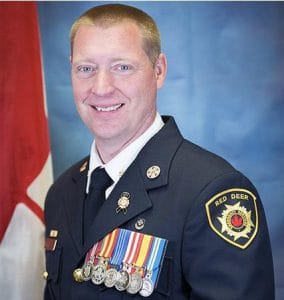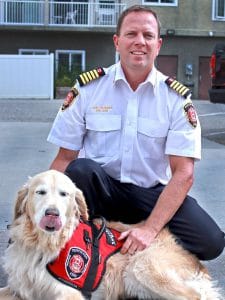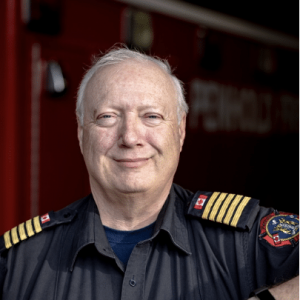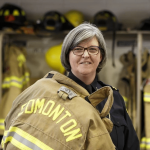Three Canadian Fire Chiefs Offer Their Best Advice for Implementing Effective Fire Prevention Programs
According to Firehouse.com, “an effective fire prevention program does not only serve the citizens but also serves fire suppression personnel. Fire prevention and mitigation efforts equate to firefighter safety.” It’s important for departments to regularly evaluate their prevention programs to make sure they meet the community’s needs. We talked to several Canadian fire chiefs to hear about the fire prevention programs they’ve implemented in their communities, and what tips they can offer to others.
Red Deer Emergency Services in Alberta delivers an integrated service model to the citizens of Red Deer, including Fire Response, EMS, EMS & Fire Dispatch and Fire Prevention. The agency has an inspection program for commercial properties, and a Home Safety Program for the community. Chief Ken McMullen says that for this program, fire crews visit approximately 2,500 homes a year to provide information and make sure the home has a working smoke alarm. Another program they do is the “After the Fire” program, which focuses on doing the home visit within 48 hours of a significant home fire, and also concentrates on the homes around the affected property. Chief McMullen points out that people tend to be more receptive to discussing safety when a fire has recently happened close to their own home.
 Red Deer Emergency Services Chief Ken McMullen
Red Deer Emergency Services Chief Ken McMullen
Chief McMullen says his advice for an effective FPP is that departments need to make sure they are targeting appropriate groups with the appropriate messaging. “If at all possible, you should try to have a method of measuring if your program has made a difference,” he says. “For example, comparing fire losses for single family dwellings year-year and to provincial statistics or having a quick questionnaire for a teacher to complete after a school presentation after it has been completed so that you can make sure the message is at an appropriate level for the audience.”
Chief McMullen believes that having an effective way to track what type of fires are happening and where they are happening is an important tool for fire prevention so that prevention efforts can be focused on where they are needed most. Also, effectively tracking this will result in being able to put out the correct messaging if there is a trend in the types of fires.
One common mistake that departments make, according to Chief McMullen, is not using standard/consistent messaging. “Our department follows the NFPA Key Fire Safety Tips when putting out safety messaging, as they have the resources to research what is the best messaging.” The NFPA lists 10 important tips to prevent home fires, such as “Give space heaters space” and “Have a home fire escape plan,” along with corresponding statistics and brochures to help educate the public.
Chief McMullen says the other mistake that some make is not placing more focus on groups/populations who tend to be more at risk.
* * * * *
The Penticton Fire Department in British Columbia is a composite dept. that has 35 IAFF members, 4 Administration and approximately 40 auxiliary firefighters. The department responds to approximately 2,500 emergency calls. Penticton FD has two IAFF Fire Inspectors that conduct routine fire inspections to about 2,250 properties. They conduct business license inspections, complaint-based inspections, and fire investigations.

Penticton FD Chief Larry Watkinson
Chief Larry Watkinson says that some of the ways the department has been involved in the community include teaming up with a high school drama class to go to all elementary schools during Fire Prevention Week to promote that year’s message. They provide spring and fall Fire Extinguisher Training to the public and local industry. They target one community a year within the city to go door-to-door promoting smoke alarms, and supply new smoke alarms or batteries if needed. They also often attend fire drills at senior care facilities and provide information on the safe evacuation of a building.
What might contribute toward an ineffective FPP? Chief Watkinson says a “lack of consistency and communication between Prevention and Suppression crews, and not having enough time to spend following up or preparing for events. This requires a full-time position.”
Chief Watkinson says effective data management is very important in creating statistics, as public education value and results are hard to quantify.
* * * * *
Jim Pendergast is the fire chief at the Town of Penhold Fire Department in Alberta, which has 35 volunteer firefighters. They respond to all emergencies, including all EMS calls – about 160 calls per year. Chief Pendergast says their department is active in the community to promote fire prevention; they visit local schools every year and talk to the students, especially during Fire Prevention Week. They also hold an open house BBQ during that week. Several times a year they attend community events, setting up displays and giving tours of the trucks. They regularly give fire hall tours to pre-k and pre-school children. They will replace any smoke alarms/CO alarms for free. If there is a fire, Chief Pendergast says they canvass the neighbourhood to talk to everyone about what happened and how to prevent it from happening again.

Town of Penhold FD Chief Jim Pendergast
Chief Pendergast says there are factors that can get in the way of an effective FPP, especially a limited budget: “Sometimes it’s not looked at as a ‘flashy’ part of your delivery services, and budgets reflect that,” he says.
Chief Pendergast’s advice for a successful fire prevention program? “Make it fun so the firefighters want to do it.”
# # #
Visit https://emergencyreporting.ca/products/prevention-package/ to learn more about Emergency Reporting’s Community Risk Reduction and Fire Prevention Software. Request a demo here.




